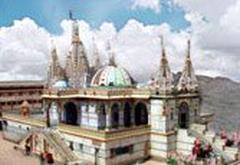
Visiting Hours and Guide to Shri Swaminarayan Mandir, Junagadh
Date: 18/07/2024
Introduction
This comprehensive guide aims to provide potential visitors with all the necessary information to enhance their experience at Shri Swaminarayan Mandir, Junagadh. From visiting hours and ticket information to travel tips and nearby attractions, this guide covers all aspects to ensure a meaningful and enriching visit.
Table of Contents
- The Significance of Hindu Temples
- The Swaminarayan Faith - A Brief Overview
- Swaminarayan Mandirs - Architectural Marvels and Spiritual Havens
- Visitor Information for Shri Swaminarayan Mandir
- Accessibility and Travel Tips
- Visiting a Swaminarayan Mandir - Etiquette and Observances
- Frequently Asked Questions (FAQ)
The Significance of Hindu Temples
Hindu temples are not merely places of worship but serve as a confluence of faith, art, architecture, and social interaction. They are considered the abode of the divine, where devotees can connect with the divine through rituals, offerings, and contemplation.
Here’s a glimpse into the key aspects of Hindu temples:
- Sacred Space - Temples are believed to be consecrated spaces, imbued with the divine presence. The deity in the temple is considered a living entity, and the temple serves as its home.
- Architecture and Symbolism - The architecture of Hindu temples is rich in symbolism, often reflecting cosmological beliefs and spiritual concepts. From the towering shikharas (spires) to the intricate carvings, every element holds a deeper meaning.
- Rituals and Offerings - A variety of rituals are performed in temples throughout the day, from the morning aarti (offering of light) to the evening bhajans (devotional songs). Devotees offer flowers, fruits, incense, and other symbolic offerings to the deity.
- Community Center - Temples also serve as important community centers, hosting festivals, religious discourses, and social gatherings. They play a vital role in preserving and transmitting Hindu traditions and values.
The Swaminarayan Faith - A Brief Overview
The Swaminarayan faith, formally known as Swaminarayan Hinduism, is a prominent branch of Hinduism founded in the late 18th century by Bhagwan Swaminarayan (1781-1830). He is believed to be an incarnation of God and is revered by his followers as the supreme being.
Here are the core tenets of the Swaminarayan faith:
- Supreme God - The faith emphasizes devotion to a single, supreme God, Bhagwan Swaminarayan, who is considered the creator, preserver, and destroyer of the universe.
- Aksharbrahma - Central to the faith is the concept of Aksharbrahma, the eternal abode of Bhagwan Swaminarayan, and the spiritual realm where liberated souls reside.
- Ekantik Dharma - Swaminarayan Hinduism emphasizes Ekantik Dharma, which encompasses righteous living, moral conduct, non-violence, and detachment from worldly desires.
- Five Eternal Entities - The faith believes in the five eternal entities - Jiva (soul), Ishwar (God), Maya (illusion), Brahma (Aksharbrahma), and Parabrahma (Bhagwan Swaminarayan).
- Salvation through Devotion - Liberation from the cycle of birth and death is achieved through unwavering devotion to Bhagwan Swaminarayan and his teachings.
Swaminarayan Mandirs - Architectural Marvels and Spiritual Havens
Swaminarayan Mandirs, built by the followers of Bhagwan Swaminarayan, are renowned for their exquisite architecture, intricate carvings, and serene atmosphere. These temples serve as both places of worship and centers for spiritual learning and community engagement.
Here’s what makes Swaminarayan Mandirs unique:
- Architectural Splendor - The temples often showcase a blend of traditional Indian architectural styles, adorned with intricate carvings depicting deities, scenes from Hindu scriptures, and floral motifs.
- Murtis (Idols) - The central focus of the temple is the murti (idol) of Bhagwan Swaminarayan, often flanked by murtis of other deities like Radha Krishna, Shiva Parvati, and Ganesh.
- Spiritual Vibrancy - Swaminarayan Mandirs are known for their spiritual vibrancy, with devotees engaging in daily rituals, devotional singing, and spiritual discourses.
- Community Service - Many Swaminarayan Mandirs are actively involved in community service initiatives, including healthcare, education, and disaster relief.
Visitor Information for Shri Swaminarayan Mandir
When planning your visit to Shri Swaminarayan Mandir in Junagadh, it’s crucial to be aware of practical information that can enhance your experience.
Ticket Prices and Opening Hours
- Opening Hours - The temple is generally open from 6:00 AM to 12:00 PM and 4:00 PM to 8:00 PM.
- Ticket Prices - Entry to the temple is usually free, but donations are welcome. Special events or guided tours may have associated costs.
Nearby Attractions
Junagadh is home to several historical and cultural sites that you can explore:
- Uparkot Fort - An ancient fort with stunning views and historical significance.
- Girnar Hills - A sacred mountain range with a series of temples and shrines.
- Mahabat Maqbara - A beautiful mausoleum showcasing Indo-Islamic architecture.
Accessibility and Travel Tips
- Accessibility - Shri Swaminarayan Mandir is accessible to visitors with disabilities. Ramps and designated areas are available for ease of movement.
- Travel Tips - Wear comfortable shoes for walking, carry a water bottle, and be prepared for weather conditions.
Visiting a Swaminarayan Mandir - Etiquette and Observances
When visiting a Swaminarayan Mandir, it’s essential to be respectful of the sanctity of the space and adhere to the temple’s customs and traditions.
Here are some general guidelines:
- Dress Code - Dress modestly, covering your shoulders and knees. Avoid wearing revealing clothing or attire that might be considered disrespectful.
- Footwear - Remove your shoes before entering the temple premises. Most temples have designated areas for footwear.
- Silence and Reverence - Maintain silence or speak in hushed tones within the temple. Avoid loud conversations or disruptive behavior.
- Photography - Photography may be restricted in certain areas of the temple, particularly near the deities. Check with temple authorities before taking pictures.
- Offerings - If you wish to make offerings, inquire about the appropriate items and procedures from temple volunteers.
- Prasad (Blessed Food) - Prasad, blessed food offered to the deity, is often distributed to devotees. Accept it with your right hand as a gesture of respect.
- Participation in Rituals - You are welcome to observe or participate in the rituals and ceremonies. However, it’s important to be respectful and follow the guidance of temple volunteers.
Frequently Asked Questions (FAQ)
- What is the best time to visit Shri Swaminarayan Mandir? The best time to visit is during the early morning or late afternoon to avoid the midday heat.
- Is there a dress code? Yes, visitors are expected to dress modestly, covering shoulders and knees.
- Can I take photographs inside the temple? Photography policies vary, so it’s best to check with temple authorities.
- Are guided tours available? Some temples offer guided tours; inquire at the temple office for more information.
By understanding the significance of Hindu temples and the core principles of the Swaminarayan faith, visitors can have a more meaningful and enriching experience at Shri Swaminarayan Mandir in Junagadh.
Conclusion
For the latest updates and more travel guides, download our mobile app Audiala, check out our other posts on historical sites, or follow us on social media. Happy travels!


